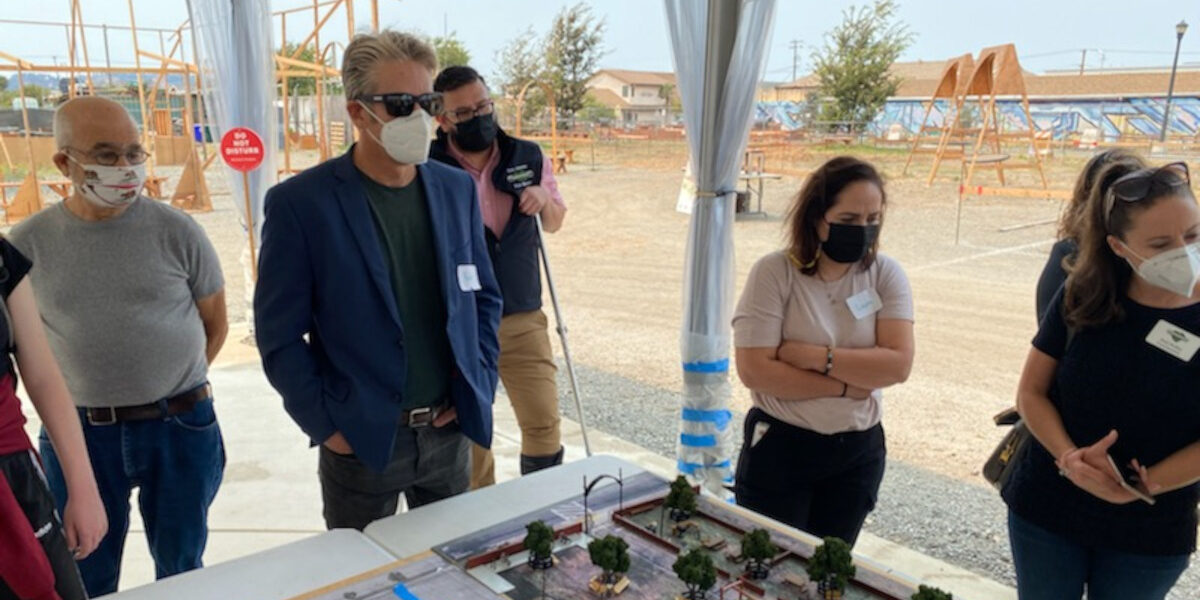

A Visit to Pogo Park
Last month, Healthcare Foundation staff visited Oakland's Pogo Park community center.
Too few are the opportunities to ride a zip line swing during work hours. But on one sunny Friday afternoon last month, it was more or less de rigueur, as Healthcare Foundation staff and a group of colleagues from several sister organizations serving northern Sonoma County gathered at a small but highly innovative neighborhood park in Richmond’s “Iron Triangle” for a remarkable tour.
Pogo Park, a nonprofit founded in 2007, recruited and trained neighborhood residents to plan, design and build a community park, Elm Playlot, at the site of a dilapidated corner playground long abandoned to drug use and discarded trash. In the process it has dramatically transformed life for the mostly African American and Latino residents of this family-heavy but historically underserved and crime-ridden residential and commercial area—a distinctive square-mile wedge of Richmond’s inner-city bounded by three railroad tracks.
As the tour participants learned firsthand from the project’s local leadership, Pogo Park’s community-led effort, which empowers residents to create and continually innovate their collective environment, has been astoundingly successful. Indeed, according to a 2017 study led by UC Berkeley professor of planning and public health Jason Corburn, it’s contributed markedly to health and wellness of the surrounding neighborhood. Among the impacts the study uncovered were a significant (27%) decrease in reported crime, a 45% increase in indicators of social connection between neighbors, a 102% increase in residents rating their neighborhood as good or excellent, and an increase in life expectancy of five years over the greater urban area.

Pogo Park is in the process of developing another site at Harbor-8 Park, a short distance away, which the Sonoma crew also had a chance to tour and hear about. Before that came a stop at nearby Scientific Art Studio, a world-renowned design and fabrication studio and a key partner to the Pogo Park team, which enjoys meeting and planning space at the Studio’s site and skills-training that the team employs in mocking up and building the parks’ structures.
Healthcare Foundation executive director Kim Bender had known about the successful model employed at Pogo Park thanks to a decades-long friendship with its founder and executive director, Toody Maher. She was also aware that at a recent monthly Comité (public meeting) hosted by Corazón Healdsburg, Spanish-speaking residents had voiced their strong desire for a community center where locals could gather, hold weddings and quinceañeras, find mental health services, attend nutrition classes, and more.

Recognizing the applicability of the Pogo Park model for northern Sonoma County and a community center envisioned by members of Healdsburg’s Latinx community, Kim reached out to colleagues and community members she thought might be interested in learning about Richmond’s successful community-led venture from the source. Her hope, says Kim, was that the tour “could kickstart a conversation among north county stakeholders and residents about how to bring about much-needed community-designed wellness centers that would truly be of, by and for community members themselves.”
And that’s just what the tour has done. Circling up at the Harbor-8 site at the tour’s end, participants enthused about the demonstrated power of community engagement—including the positive health impacts and many other benefits it brings—and vowed to keep the conversation and momentum going back home.
To be continued!

Related News + Stories
Invest in Our Community
Your support is vital to our collective vision of eliminating health inequities in northern Sonoma County.
Donate



